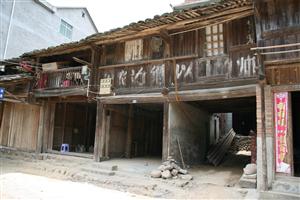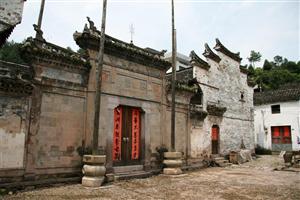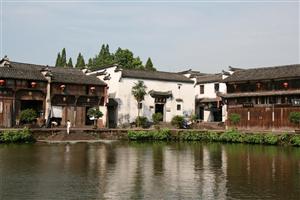Wei Zhao traveled to China to document vernacular settlements.
My trip to China in the summer of 2012 was to visit vernacular settlements that were located along important trade routes and influenced by business activities. The goal of my trip was to gather preliminary data and select possible sites for my dissertation. I mainly focused on vernacular settlements along two major trade routes, the Xianxia Historic Route and the Tea Horse Road.
The Xianxia Historic Route was one of the two busiest commercial routes in pre-modern China since the Ming Dynasty (1368–1644), while the other one was the Grand Canal. The Xianxia Historic Route was part of an extended trade route that connected the fertile Yangzi Delta to Canton in Guangzhou province, which was the only port city that was permitted to handle foreign trades between 1523 and 1566, as well as between 1757 and 1842. The Xianxia Historic Route, about 75 miles long, was the overland route between Zhejiang and Fujian provinces that connected the two water systems on either sides of the Xianxia Mountain. Qinghu, Nianbadu, and Guanqian are existing historic towns or villages that were populated by travelling businessmen and porters, as well as packed with shops, restaurants, and hotels. There was a bypass for this trade route, which was detoured to the west into Jianxi province to avoid climbing the mountain with heavy goods. Hekou was a port town along this bypass. The vernacular built environments of all these places were greatly influenced by the commercial activities; Nianbadu is currently affected by tourism development.

Vernacular architecture in Guanqian, China
The Tea Horse Road was an extended network that connected Yunnan province and Tibetan region. It was named after the two major goods transported along the winding paths through the mountains: tea and horses. From south to north, Xizhou, Shaxi, Shuhe, and Shangri-La were once important trading towns along this road. They were also regional centers for different ethnic groups, including Bai (Xizhou and Shaxi), Naxi (Shuhe), and Tibetan (Shangri-La). The vernacular built environments of these places not only show impacts from past commercial activities, but also represent cultural heritage of different ethnic groups. Meanwhile, the increasing domestic and international tourists have introduced the ideas of modernization and globalization.

Residential architecture in Yuyuan, China
In addition, I also visited Yuyuan and Zhuge, two relatively isolated and intact vernacular settlements in Zhejiang province. Although Yuyuan and Zhuge are only 40 miles apart, their vernacular built environments represent two distinct styles. The buildings in Zhuge are exemplars of the Huizhou style, a vernacular architectural style dominated in Anhui province, while buildings in Yuyuan represent typical vernacular buildings in this part of Zhejiang province. The reason for this difference is because Zhege was more closely connected to Anhui province due to commercial activities; the once rich and famous businessmen from Anhui province traveled through Zhuge to send their goods to the port cities further to the southern and eastern part of China.

Residential architecture in Shuge, China